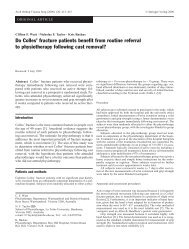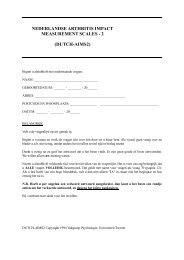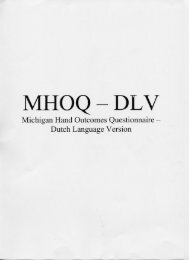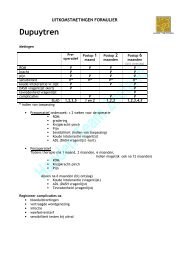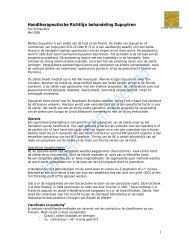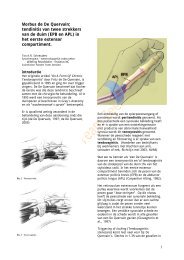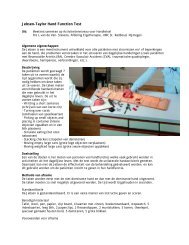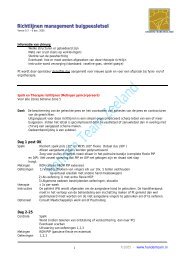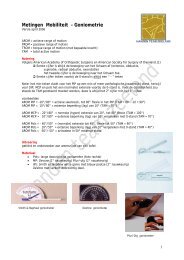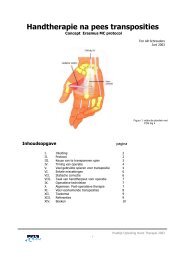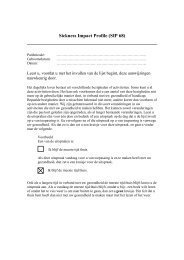Muscle strength measurements of the Hand - Handen Team Zeeland
Muscle strength measurements of the Hand - Handen Team Zeeland
Muscle strength measurements of the Hand - Handen Team Zeeland
Create successful ePaper yourself
Turn your PDF publications into a flip-book with our unique Google optimized e-Paper software.
Ton A.R. Schreuders, JW Brandsma, HJ Stam<br />
manufactured a new device called <strong>the</strong><br />
Intrins-o-meter. 20 In 1997 he reported a<br />
study in 48 patients with ulnar nerve<br />
compression. 21 Rosen et al. noted that<br />
assessing muscle function using <strong>the</strong><br />
Intrinsi-o-meter was difficult due to <strong>the</strong><br />
extremely small forces, and <strong>the</strong> instrument<br />
was difficult to handle and read. They<br />
suggested using MMST and grip <strong>strength</strong><br />
<strong>measurements</strong> to evaluate nerve function.<br />
Interestingly <strong>the</strong>y found a poor recovery <strong>of</strong><br />
<strong>the</strong> intrinsic muscle <strong>strength</strong> with <strong>the</strong><br />
Mannerfelt instrument and good grip<br />
<strong>strength</strong> recovery.<br />
22 23<br />
Several o<strong>the</strong>rs have developed<br />
instruments mainly to assess <strong>the</strong><br />
abduction <strong>of</strong> <strong>the</strong> thumb. 24-26 Some needed<br />
a specially constructed jig, e.g. to measure<br />
wrist, finger (metacarpo-phalangeal joints)<br />
and thumb extension <strong>strength</strong>. 27<br />
Rotterdam Intrinsic <strong>Hand</strong> Myometer<br />
(RIHM) (Figure 3)<br />
In 1995 inventories were made at<br />
our department to establish which clinical<br />
evaluation instruments were available to<br />
assess <strong>the</strong> outcome after peripheral nerve<br />
surgery. Three methods were <strong>of</strong>ten used<br />
to assess <strong>the</strong> recovery <strong>of</strong> muscle <strong>strength</strong>:<br />
MMST and grip and pinch <strong>strength</strong><br />
dynamometers.<br />
Having encountered several<br />
patients with good grip <strong>strength</strong> but poor<br />
recovery <strong>of</strong> <strong>the</strong> intrinsic muscles <strong>strength</strong>,<br />
we questioned whe<strong>the</strong>r grip <strong>strength</strong><br />
<strong>measurements</strong> were appropriate. We<br />
acknowledged <strong>the</strong> need for a<br />
dynamometer to measure <strong>the</strong> intrinsic<br />
muscles in isolation. Such a dynamometer<br />
should be easy to handle, e.g. portable<br />
and with an ergonomical design. It should<br />
also have <strong>the</strong> possibility to measure <strong>the</strong><br />
opposition force <strong>of</strong> <strong>the</strong> thumb. Reliability<br />
should be good with acceptable<br />
measurement error making it possible to<br />
detect reasonably small changes in<br />
muscle <strong>strength</strong>.<br />
Figure 3 RIHM dynamometer<br />
The Intrinsic <strong>Muscle</strong>s<br />
<strong>of</strong> <strong>the</strong> <strong>Hand</strong>:<br />
Function, Assessment and<br />
Therapy principles<br />
Introduction<br />
There have been many valuable<br />
studies concerning <strong>the</strong> anatomy 28-30 ,<br />
mechanics, 2 31 32 and architectural<br />
design, 33 <strong>of</strong> <strong>the</strong> intrinsic muscles <strong>of</strong> <strong>the</strong><br />
hand. Understanding <strong>the</strong> mechanics <strong>of</strong><br />
human dexterity requires an appreciation<br />
<strong>of</strong> <strong>the</strong> kinetic chains that comprise <strong>the</strong><br />
hand, and <strong>the</strong> intricate interplay <strong>of</strong><br />
muscles and ligaments that control its<br />
movements. 2 In <strong>the</strong>se chains, <strong>the</strong> intrinsic<br />
muscles <strong>of</strong> <strong>the</strong> hand are <strong>of</strong> paramount<br />
importance for efficient hand function. 33<br />
There is a considerable decrease<br />
in functional efficiency in hands with loss<br />
<strong>of</strong> <strong>the</strong> intrinsic muscles function, <strong>of</strong>ten<br />
referred to as <strong>the</strong> clawhand or intrinsic<br />
minus hand (Figure 1). 34-36<br />
A comprehensive analysis <strong>of</strong> hand<br />
function should include assessment <strong>of</strong> <strong>the</strong><br />
<strong>strength</strong> and length <strong>of</strong> <strong>the</strong> intrinsic<br />
muscles. This will provide important<br />
information and assist <strong>the</strong> assessor in e.g.<br />
determining nerve function, deciding which<br />
muscles need to be <strong>strength</strong>ened, what<br />
splint is needed, what surgery needs to be<br />
considered (tendon transfer), etc.<br />
Although assessment <strong>of</strong> muscle<br />
<strong>strength</strong> and length are important<br />
elements <strong>of</strong> hand function o<strong>the</strong>r functions,<br />
e.g. mobility, sensibility and central<br />
properties <strong>of</strong> <strong>the</strong> brain, are equally or more<br />
important for hand function. The latter<br />
4



